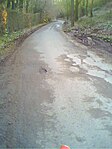The Battle of Oudenarde, also known as the Battle of Oudenaarde, was a major engagement of the War of the Spanish Succession, pitting a Grand Alliance force consisting of eighty thousand men under the command of the Duke of Marlborough and Prince Eugene of Savoy against a French force of eighty-five thousand men under the command of the Duc de Bourgogne and the Duc de Vendôme, the battle resulting in a great victory for the Grand Alliance. The battle was fought near the city of Oudenaarde, at the time part of the Spanish Netherlands, on 11 July 1708. With this victory, the Grand Alliance ensured the fall of various French territories, giving them a significant strategic and tactical advantage during this stage of the war. The battle was fought in the later years of the war, a conflict that had come about as a result of English, Dutch and Habsburg apprehension at the possibility of a Bourbon succeeding the deceased King of Spain, Charles II, and combining their two nations and empires into one.The engagement itself came about after a series of offensive and defensive manoeuvres between an Allied army under the command of Marlborough and a French army under the command of the Duc de Bourgogne. The two French commanders quarrelled about the direction their army should take, although roughly a month before the battle, the French army moved westwards and captured the Allied-held fortresses of Bruges and Ghent. This proved to be an unexpected and worrying action to Marlborough, who waited until Eugene had joined his army before he decided to undertake any offensive operations. The French moved to attack again, aiming to capture the city of Oudenarde, which would cut off communication and supply routes between Marlborough and England and thus allow for a significant victory over the Grand Alliance. Marlborough managed to figure out the French plan of action, and forced marched his men towards Oudenaarde to defend it from the expected French attack. On 11 July, the two forces met near the city.During the engagement, Allied cavalry moved to engage the French forward positions, killing or capturing many French soldiers and pushing them back. For unknown reasons, a significant portion of the French army kept in reserve was never ordered to move up and engage, thus leading to a significantly weakened French force facing the Allies. The infantry battalions on both sides moved to engage each other, with skilled deployment of cavalry by Cadogan ensuring the rout of many of the French infantry battalions, weakening the French positions. Both sides settled into an engagement on opposing sides of the river, with several further mostly fruitless cavalry charges attempted by both sides. Marlborough initiated a flanking manoeuvre, gaining the allies a significant tactical and strategic advantage. Faced with mounting casualties, the French commanders made the decision to withdraw from the field. The battle was the third major victory that Marlborough had obtained during the war; boosting his military renown alongside that of Eugene, whose tactical contributions were vital to this victory.









